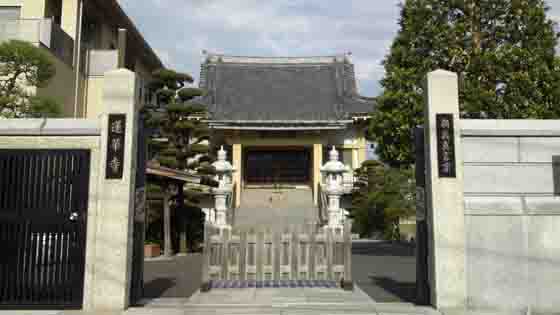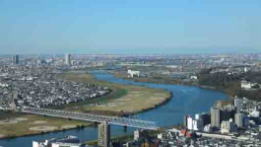Nakayama is in between Narita And Haneda International Airport
<クッキーについての同意並び欧州居住者向けプライバシーポリシー>
中山・下総・散歩道
Ninoe Jinja Shrine along Furukawa Shinsui Koen Park






Ninoe Jinja Shrine is a shrine standing along Furukawa Shinsui Koen Park. Seeing from the park, it looks very mysterious that the back yard of the shrine is covered with thick woods, but it looks very beautiful with the main hall of the shrine in the deep end of the approach with red lanterns and tall green pine trees while seeing from the main gate. There are many tall pine trees standing in the site and a 500 years-old giant zelkova tree standing in the back yard of it. They look excitingly beautiful under the blue sky.
Ninoe Jinja Shrine and Furukawa Shinsui Koen Park, Myoshoji Temple are very close, and they create a green belt like an oasis.
Why don't you visit Ninoe Jinja Shrine?
Ninoe Jinja Shrine
Ninoejinja Shrine
Ninoe Jinja Shrine became the guardian deity of Ninoe Village in 1873 called Katori Jinaja Shrine. Alhough there are no information when it was built, it has stood here and has dedicated Futsunushi no Mikoto.Hachiman Jinaja Shrine was built in Kanbun era from 1661 to 1673 and it dedicates Hondawake no Kami. Originally, it was in Myoshoji Temple and it was called Sanjuban Shin who is the guardian deity of the Lotus Sutra. In December 1967, Hachiman Jinja Shrine was moved, and Futsunushi no Mikoto (Katori Jinja) and Homudawake no Kami (Hachiman Jinja) were enshrined together at Ninoe Jinja Shrine as a new shrine.
The Zelkova Tree in Ninoe Jinja Shrine
The Zelkova Tree in Ninoe Jinja Shrine is a plant registered as a natural property by Edogawaku in January 1981.Furukawa River flows in the north side of Ninoe Jinja Shrine had used as a canal in Tensho Era from 1573 to 1592 that had brought salt produced at Gyotoku to Edo. There is the Zelkova Tree standing in Ninoe Jinja Shrine only tells those days. It is said to be 500 years-old, it is over 20 meter tall and its trunk 1.6 meters around in girth, so it is one of the giant trees in Edogawaku.
平成21年3月
江戸川区教育委員会
二之江神社本殿脇案内板より
引用、抜粋並びに参考
二之江神社本殿脇案内板
江戸川区ホームページ
Landmarks near Ninoe Jinja Shrine

Furukawa Water Park
It is the first water park in Japan and a famous spot for viewing Sakura and hydrangeas.。
Honkakusan Myoshoji Temple
An old temple has a beautiful garden with many seasonal flowers in it.
Kaishosan Rengeji Temple
The principle image is the statue of Sho Kanzeon Bosatsu carved by Gyoki.
Kumano Jinja Shrine
This shrine stands where famous and popular tasty water flows in the river.
Eichosan Josenin Chokoji Temple
It is called Akamondera dedicates Shichimen Daimyojin.The Location and Access to Ninoe Jinja Shrine

The map of the noted spots along Furukawa Water Park and Kasai
The Map of the landmarks along Furukawa Water Park and in KasaiNinoe Jinja Shrine
- Ninoe Jinja Shrine has great accessibilities from both Narita and Haneda International Airport.
- From Narita International Airport, take Sobu Express Line bound to Tokyo or Yokosuka and get off at Funabashi Sta, then transfer the line to Sobu line bound to Nakano or Mitaka ang get off at Motoyawata Sta. Or take Keisei-line bound to Ueno and get off Keisei Yawata Sta. Both from Motoyawata Sta and Keisei Yawata Sta, transfer the line to Toei Shinjuku line and get off at Ichinoe Sta.
- From Haneda International Airport, take Keikyu-line bound to Narita, and get off Shinagawa Sta and transfer the line to Sobu Express line bound to Narita International Airport or Chiba, and transfer the line at Ichikawa Sta to Sob line bound to Nishi Funabashi, Tsudanuma or Chiba and get off at Motoyawata Sta. Or take Keikyu-line bound to Narita, and get off Keisei Yawata Sta. Both from Motoyawata Sta and Keisei Yawata Sta, transfer the line to Toei Shinjuku line and get off at Ichinoe Sta.
- From Iwamotocho Station at Akihabara, take Toei Shijuku line bound to Motoyawata and get off Ichinoe Sta.
- Take 16 minute walk from Ichinoe Sta.
- 6-44 Edogawa, Edogawaku, Tokyo
The Noted Spots around Funabori, Ichinoe and Kasai

The Observatory on Tower Hall Funabori
Visitors could enjoy seeing some special views of Tokyo.
A Walk Along Shinkawa River
There are some Edo style, some wooden buildings and thousands of cherry trees along the river.
Thousands of Cherry Trees along Shinkawa River
In spring, thousands of sakura along it beautifully bloom.
Shinkawa Nishi Suimon Hiroba Plaza
There are a Edo style fire lookout and an old lock gate in the plaza.
Furukawa Water Park
It is the first water park in Japan and a famous spot for viewing Sakura and hydrangeas.
Honkakusan Myoshoji Temple
There are some seasonal flowers blooming in every season, sakura especially blooms beautifully.
Ninoe Jinja Shrine
There are several tall pine trees and a 500 years old giant zelkova tree in the shrine.
Kaishosan Rengeji Temple
The principle image is the statue of Sho Kanzeon Bosatsu carved by Gyoki.
Kumano Jinja Shrine
There is a stone tablet scribing a haiku poem written by Basho Matsuo.
The Remain of the Ferry at Imai
The ferryport at Imai is appeared on an essey written by Socho, a renga poet in Muromachi period.
Ichinoe Sakaigawa Water Park
The park has many sakura and seasonal flowers, visitors could enjoy all seasons.
Iousan Myouonji Temple
It has the legend 'the One-eyed Crucial Carps' telling the miracle power to cure eye diseases.
Ichinoe Makkotei Residence Park
In spring, weeping cherry trees bloom, in fall, colored leaves decorate the garden.
The Residence of Ichinoe Nanushi Yashiki
The traditional Japanese style residence with a thatched roof.
Honkosan Joryuji Temple
It is an important temple to know the history of Ichinoe area.
Chogyosan Daiunji Temple
It has tombs of Kabuki Yakusha and it is called Yakushadera.
A Walk Along Edogawa River
The areas along the river have many noted spots that people could enjoy history and culture.
A Walk Along Shinnakagawa River
There are some historical and cultural spots along the river.- 広告 Advertisement -
